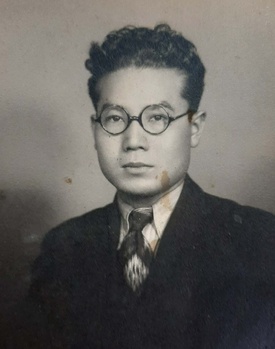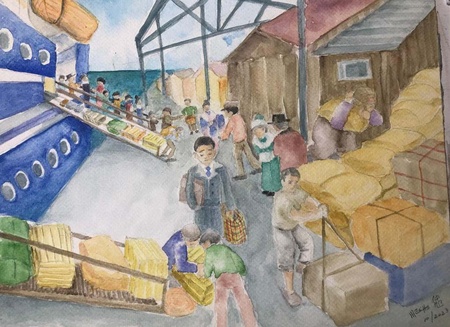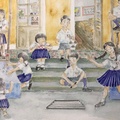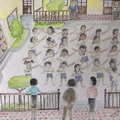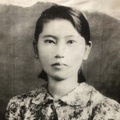My father, Masao Nakachi, was born in Motobu, Okinawa. He migrated to Peru very young. He only went to elementary school, but he never stopped dreaming of going to university. He was a man who managed to do a lot for the Japanese colony and for the land that welcomed him (Peru). He always remained humble, often alone in the shadows, sometimes forgotten, and finally recognized.
He served as president of the Peruvian Japanese Association (APJ) in 1976-77. He received the Order of the Sacred Treasure decoration from the Japanese Government for his multiple contributions to relations between Peru and Japan. He worked at the Santa Beatriz Japanese Primary School ( Jishuryo ) and at the La Unión School as a cook in the school cafeteria.
With his wife Kiyomi and his son Toshimitsu (Jorge Federico) he managed the Nakachi Restaurant at the Peruvian Japanese Cultural Center (CCPJ), promoting and enriching Nikkei gastronomy. He was a lover of music, arts and books. He played the violin and liked to sing, he painted in the Jinnai Painting workshop of the CCPJ and he was always seen with a book in his hands. This is the story that my father told me, calling himself “the little immigrant”…
* * * * *
In Motobu
I was fourteen or fifteen years old at the time in Motobu, Okinawa. News came to town from my cousins who were in Peru. They were doing well at the restaurant they had on the corner of Colmena Izquierda in Lima and they needed help. I always heard, here and there, something about Peru. They said that there was a lot of work in the fields, that the climate was mild and it never rained, that the people were happy, and some even looked a lot like us, and that the city was modern and elegant.
The people did not just send anyone to Nambei (South America). Every year there was a very difficult exam and only four boys were selected to travel. That year, it would be 1926, my parents decided that I would take the exam. I still wonder why they did it, but how glad I was! Perhaps the winds of the great changes that were shaking the country had already reached my small town.
Emperor Meiji had opened Japan to the world. The country was mired in backwardness and poverty and was trying to escape feudalism in the whirlwind of modernization and Westernization. There was uncertainty, but at the same time, there were totally new opportunities. Maybe I was still too young to understand it, but all this was already seen in my town. The winds were too strong not to feel them.
- Let's go to America...! - could be heard everywhere on the small island.
All applicants met in a large room. Nervous and excited we commented:
- They say that the exam is very difficult...
- I hope I can go! - I wanted one.
- Come on, let's try hard! - exclaimed one of the older ones.
One by one we sat on the tatami in front of a small table. On the table there was a piece of paper and a pen. Soon we were all focused and serious writing the answers on paper. I passed the exam.
Twenty-seven years after the first Japanese ship, the Sakura Maru, left with immigrants for America, I left for Peru. I remember that my great-aunt lent us 300 yen and bought me a new, fine hat for the trip to Peru.
Rakuyo Maru
Standing on the deck of the ship that brought me to Peru, the Rakuyo Maru , I watched my land move away. The whole town was on the beach waving their handkerchiefs. In the crowd I could distinguish my parents and my brothers.
- Will I ever see them again? - I asked myself and felt a lump in my throat.
- Sayonará …!
We exclaimed again and again until I realized that they couldn't hear us anymore. The excitement of the moment gradually gave way to the feeling of loneliness... of feeling alone for the first time.
The island was fading away on the horizon. Soon all you could see was the sea in its great immensity, full of waves and reflections. Seagulls flew in the sky, their sounds accompanied us for a long distance until we were also left behind.
We passed through Kobe and got off in Yokohama. We walked through Tokyo, bustling and vital, so different from the quiet life of my town. In Osaka they boarded a group of Chinese migrants. From there the long 38-day journey began.
Below deck, families soon adapted to the small space they had been allotted and endured the slow, monotonous passage of days at sea. On the deck, the sailors went about their daily tasks. The children ran around and played at dusk. We boys walked around the ship, talking or reading. With a certain nostalgia we looked at the sea in the direction of our island. As the days passed, we anxiously hoped to see the coast of America on the horizon.
A young officer from the ship " Rakuyo Maru " made our voyage pleasant. He showed us the boat, let us enter the cabin for a while and, from time to time, treated us to his portion. The food tasted different at sea.
I only remember one unusual incident on the ship. It was midday on the high seas after weeks of travel. The routine on the ship was always the same. Breakfast, lunch and dinner followed one another monotonously between sunrise and sunset. The sailors did their work on the deck rocked by the rolling of the sea, somewhat numbed by the sway and heat.
It was lunch time. The sun was shining overhead. Families had gathered around the table right under the open hatch to enjoy the light and sun. The wind blew soft and refreshing. The women served the food and chatted happily. The men and boys, with great appetite, ate in silence.
BANG…! It resounded loudly as the hatch of the ship above us slammed shut. Upstairs you could hear footsteps and suppressed laughter. After a few moments, the hatch opened a little, letting in a thin ray of light. Cautiously, full of curiosity to see what they had caused, smiling and mocking, the dark faces of the young Africans peeked out. Their laughter filled the entire ship.
Below deck, dust had fallen on the tables. Everyone looked up in surprise, full of dust and without food. Recovered from the initial shock, we shouted angrily:
- Hey, those above...! …..What do you think you are doing?
- Sonsos...!
- Look what they've done...!
- Ha, ha, ha……You could hear the boys' laughter.
Annoyed, we go up on deck and get into a fight with the African boys until the Captain and his crew separate us and calm us down.
Finally we sighted the coasts of America. We arrived first in San Francisco where a small group came down. After a few days we left for Peru.
What excitement to see the Port of Callao! A dense fog covered the coast. Everything looked gray and foggy. A soft gust fell on the deck.
As I got off the boat and set foot in the harbor, someone suddenly took away my fine new hat that my aunt had given me in Okinawa.
I wanted to think that it was the wind that received me like that. I felt the breeze play on my hair, the soft breeze on my cheeks, and the faint fog in front of my eyes. He had arrived in Peru.
© 2023 Graciela Nakachi


